
St. Stephen's Episcopal Church is a historic church located at 196 Brick Church Circle in St. Stephen, South Carolina. Built in the 1760s, it is one of a handful of surviving 18th-century brick parish churches in the state, with a number of architectural features not found on any other of the period. It was declared a National Historic Landmark in 1970.
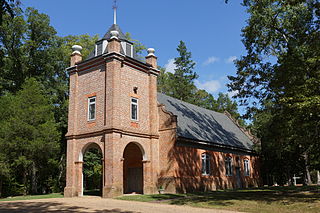
St. Peter's Church is a historic Episcopal church near Talleysville, Virginia, United States. Built in 1703, the church was designated as "The First Church of the First First-Lady" by the Virginia General Assembly in 1960 and added to the National Register of Historic Places in 1969. It was designated a National Historic Landmark on March 2, 2012, as an exceptionally well-preserved colonial-era church.

The First Christian Church is a historic Disciples of Christ church located at 101 North Tenth Street in Columbia, Missouri. It was designed by T.N. Bell of Chicago, Illinois and built in 1893. It has a Richardsonian Romanesque style Sanctuary that includes a square bell tower, horizontal massing with contrasting high gables, round arches, heavy and highly textured stone work, and voussoir arches. The Education Building was designed by Eugene Groves and added in 1929. This is the second church building to stand at this site. The building is still a functioning church today.
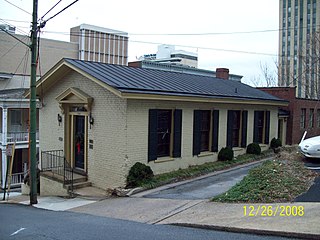
The Saint Paul's Vestry House is a historic building in Lynchburg, Virginia, United States. It was built about 1855 and is a single-story Classical Revival-style building with a simple low pitched gable roof and a rectangular plan. It is likely the only vestry house built exclusively for the governing body of an Episcopal Church in Virginia. It also served as the first home of the Lynchburg Woman's Club from 1903 to 1916.

St. Mark's Episcopal Church is an historic Episcopal church building at 6 Freeland Street in Worcester, Massachusetts. The Romanesque Revival stone building was designed by local architect Stephen C. Earle, and built in 1888 for a congregation established the preceding year. On March 5, 1980, the church building was added to the National Register of Historic Places as St. Marks. The current minister is Rev. Donald F. Chamberlain.

Immanuel Episcopal Church is a historic Episcopal church and cemetery located near Mechanicsville, Hanover County, Virginia.

Old Rectory of St. Stephen's Episcopal Church is a historic Episcopal church rectory located near Perrowville, Bedford County, Virginia. It was built in 1787, and is a "T"-shaped frame dwelling with exterior end chimneys and a gable roof. It features a modern one bay, two-story portico supported by four fluted Doric order columns. From around 1828 to 1904, the house served as the rectory of St. Stephen's Episcopal Church.

Virginia City Church is a historic church located near St. Paul, Wise County, Virginia. It was built about 1895, and is a small, one-room frame vernacular church. It has a front gable roof and is covered with weatherboard. The rectangular building measures 20 feet by 32 feet. It was built by Virginia City coal camp residents on land donated by the Russell Creek Coal Company. The building also served the community as its first schoolhouse.

St. Stephen's Church, also known as St. Stephen's Episcopal Church, is an historic church located at 6807 Northumberland Highway, Heathsville, Northumberland County, in the Northern Neck of Virginia. Built in 1881, it was designed in the Carpenter Gothic style by T. Buckler Ghequiere. On December 28, 1979, it was added to the National Register of Historic Places. It remains in use by an active parish in the Episcopal Diocese of Virginia. It is located in the Heathsville Historic District.
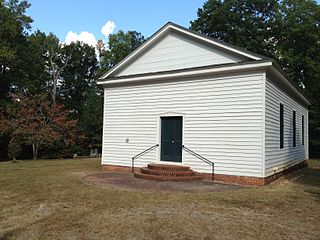
Sappony Church, also known as Sapony Church and Sappony Episcopal Church, is a historic Episcopal church located at McKenney, Dinwiddie County, Virginia. It was built in 1725-1726, and is a one-story, three bay long, rectangular frame building with a low gable roof. A vestry room was added early in the 19th century; the building was remodeled in the mid-19th century and again in 1870.

Vauter's Church, also known as Vauter's Episcopal Church, is a historic Episcopal church located at Loretto, Essex County, Virginia. It was built in 1719, and is a one-story, "T" shaped brick building with a gable roof. The south wing was added in 1731. Vauter's is the upper Church of St. Anne's Parish.

St. Thomas Chapel, also known as St. Thomas Episcopal Church or St. Thomas Protestant Episcopal Chapel, is a historic building located at 7854 Church Street in Middletown, Frederick County, Virginia, United States. Built in the 1830s, regular services were held at the Episcopal church for almost 100 years. The building has been restored twice, once after being heavily damaged during the Civil War, and again in the 1960s. The church was added to the Virginia Landmarks Register (VLR) and the National Register of Historic Places (NRHP) in 1973.
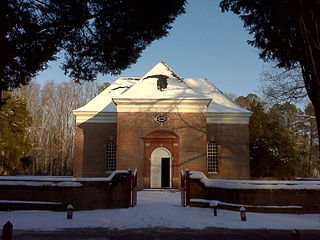
Christ Church is a historic Episcopal church located at Saluda, Middlesex County, Virginia. It was constructed in 1712-1714, and is a one-story, rectangular brick building with a gable roof. It measures 60 feet by 33 feet, 6 inches. The church was restored in 1843, and a gable-roofed vestibule added. Burials in the churchyard include Congressman Andrew Jackson Montague and Chesty Puller.
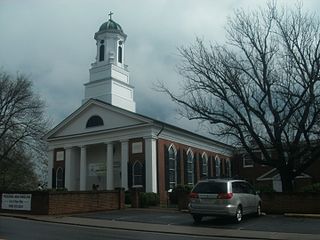
St. Thomas Church is a historic Episcopal church located at Orange, Virginia, United States. It is a rectangular brick structure measuring 40 feet wide and 105 feet deep. The front facade features a recessed portico with two Doric columns flanked by two Doric pilasters. Atop the gable roof is a three-stage tower topped by an octagonal cupola. The original church building was built in 1833-1834, and measured approximately 40 feet wide and 65 feet deep. It was built by William B. Philips, a master mason employed by Thomas Jefferson during the construction of the University of Virginia. It was enlarged and improved in 1853, and enlarged again in 1912. In 1928, the rear addition was raised to a full two stories and a parish hall constructed. The original church is believed to have been based on the plans by Thomas Jefferson for Christ Church in Charlottesville, Virginia. That church was demolished in 1895.

St. Luke's Episcopal Church is a historic Episcopal church in Fine Creek Mills, Virginia, United States. It was built in 1843-1844, and is a one-story, Classical Revival style brick church building. It measures 20 feet wide by 36 feet deep, and features a pedimented front gable roof.

Snowville Christian Church, also known as Cypress Grove Christian Church, is a historic Christian Church church complex located in Snowville, Pulaski County, Virginia. It was built in 1864, and is a one-story, gable-roofed frame church building. The building measures 40 feet by 60 feet. It features pattern-book Greek Revival style columns and pilasters and the principal facade is topped by an octagonal bell tower.

St. John's AME Church is a historic congregation of the African Methodist Episcopal Church in Norfolk, Virginia, United States. Founded in 1840, it was the first African American Episcopal Church in Virginia. It moved to its present location on East Bute Street in what is now Downtown Norfolk in 1848.
Christ Church was a historic Episcopal church located at Norfolk, Virginia. It was built in 1828, and was a one-story, temple form church in the Greek Revival style. It was fronted by a distyle portico with two unfluted Greek Doric order columns. It measured approximately 64 feet by 96 feet, and featured a cupola with octagonal belfry. The congregations roots can be traced back to 1637. In 1798, the congregation of Borough Church split into two factions, with the other being Saint Paul's Episcopal Church. Christ Church merged their congregation with St. Luke's in 1910, and the building housed a Greek Orthodox congregation until 1955. It was demolished in January 1973.

St. John's Episcopal Church is a historic Episcopal church in Roanoke, Virginia, United States. It was built in 1891–1892, and is a Gothic style blue-gray limestone church designed by Charles M. Burns of Philadelphia. It has a nave-plan with side aisles, a corner bell tower, a sacristy wing, and a transverse chapel and narthex to the rear. The nave features a hammerbeam roof and wooden arcading and is illuminated by stained glass windows in the clerestory and side aisle walls including several by Louis Comfort Tiffany. Attached to the church by a stone addition built in 1958, is a Tudor Revival style Parish House built in 1923.

Belmont Methodist-Episcopal Church, also known as Metropolitan Community Church of the Blue Ridge, is a historic Methodist Episcopal church located in the Belmont neighborhood of Roanoke, Virginia. It was built between 1917 and 1921, and is a three-story, brick Late Gothic Revival style church. It features a tall bell tower, complex roof form, steeply-pitched gables and parapets, large pointed arch windows, crenellated corner towers, buttresses, cast-concrete quatrefoils and other detailing.



























